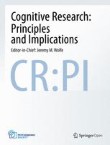This thematic series, published in Cognitive Research: Principles and Implications, focuses on spatial ability and spatial thinking.
People's thinking about, with, and in space has been extensively studied in the literatures of psychology, education, and other related fields. In the context of education, researchers have shown that spatial ability correlates significantly, over and above mathematical and verbal ability, with students' interest in STEM disciplines, and affects their eventual occupational choices.
The existence of large individual differences in the extent, accuracy, and flexibility of internal representations of our spatial environments is now stimulating research. The pervasive availability of geospatial information raises concern about negative effects on people’s geospatial literacy and awareness. This special issue aims to bring together articles on questions such as: What is spatial thinking? Is it related to spatial ability and other abilities? To academic achievements in different fields? Can it be taught and trained? Brought into the classroom?
Edited by:
- Toru Ishikawa
- Nora Newcombe
This collection of articles has not been sponsored and articles have undergone the journal’s standard peer-review process. The Guest Editors declare no competing interests.
1. Spatial Thinking and the Skill of Mental Rotation
1.1 Spatial thinking in infancy: Origins and development of mental rotation between 3 and 10 months of age
Scott P. Johnson and David S. Moore
1.2 Strengthening spatial reasoning: Elucidating the attentional and neural mechanisms associated with mental rotation skill development
Katherine C. Moen, Melissa R. Beck, Stephanie M. Saltzmann, Tovah M. Cowan, Lauryn M. Burleigh, Leslie G. Butler, Jagannathan Ramanujam, Alex S. Cohen and Steven G. Greening
1.3 Spatial anxiety mediates the sex difference in adult mental rotation test performance
Daniela Alvarez-Vargas, Carla Abad and Shannon M. Pruden
1.4 Telling right from right: The influence of handedness in the mental rotation of hands
You Cheng, Mary Hegarty and Elizabeth R. Chrastil
1.5 Spatial ability contributes to memory for delayed intentions
Veit Kubik, Fabio Del Missier and Timo Mäntylä
2. Spatial Thinking in the Classroom Context or in STEM Curricula
2.1 Situating space: Using a discipline-focused lens to examine spatial thinking skills
Kinnari Atit, David H. Uttal and Mike Stieff
2.2 Gesture during math instruction specifically benefits learners with high visuospatial working memory capacity
Mary Aldugom, Kimberly Fenn and Susan Wagner Cook
2.3 When it all falls down: The relationship between intuitive physics and spatial cognition
Alex Mitko and Jason Fischer
2.4 Focus on the notice: Evidence of spatial skills’ effect on middle school learning from a computer simulation
Colleen M. Epler-Ruths, Scott McDonald, Amy Pallant and Hee-Sun Lee
2.5 Unpacking the Black Box of Translation: A framework for infusing spatial thinking into curricula
Kristin M. Gagnier and Kelly R. Fisher
2.6 Elementary teachers’ attitudes and beliefs about spatial thinking and mathematics
Heather Burte, Aaron L. Gardony, Allyson Hutton and Holly A. Taylor
3. Spatial Thinking in Wayfinding or Large-Scale Spatial Cognition
3.1 Reference frames in spatial communication for navigation and sports: An empirical study in ultimate frisbee players
Steven M. Weisberg and Anjan Chatterjee
3.2 Exploring the effects of geographic scale on spatial learning
Jiayan Zhao, Mark Simpson, Jan Oliver Wallgrün, Pejman Sajjadi and Alexander Klippel
3.3 Where are we going and where have we been? Examining the effects of maps on spatial learning in an indoor guided navigation task
Mallory C. Stites, Laura E. Matzen and Zoe N. Gastelum
3.4 Improving cognitive mapping by training for people with a poor sense of direction
Toru Ishikawa & Yiren Zhou
3.5 Uncertainty promotes information-seeking actions, but what information?
Ashlynn M. Keller, Holly A. Taylor and Tad T. Brunyé
3.6 Spatial activity participation in childhood and adolescence: Consistency and relations to spatial thinking in adolescence
Emily Grossnickle Peterson, Adam B. Weinberger, David H. Uttal, Bob Kolvoord and Adam E. Green
3.7 Childhood wayfinding experience explains sex and individual differences in adult wayfinding strategy and anxiety
Vanessa Vieites, Shannon M. Pruden and Bethany C. Reeb-Sutherland
